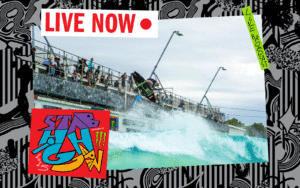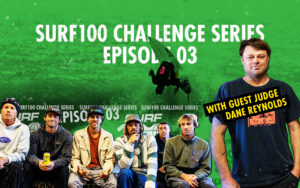Surfer attacked by shark in Cape Town
All photos – Ian Thurtell Muizenberg, Cape Town, South Africa – A young male surfer was attacked by a shark while surfing at Muizenberg in Cape Town. The shark was reported to be a great white and the 20-year-old surfer was bitten on both legs. Full rescue services, including a helicopter, were on the scene to assist the injured surfer and airlift him to hospital. Muizenberg, and False Bay in general, has a long history of shark sightings and attacks, and the problem has gotten worse in recent years. Nearby Seal Island is a smorgasbord for sharks, because as the name suggests, thousands of seals use the island to breed. On top of this, across False Bay lies Gaansbaai, the epicentre of the shark cage diving industry in South Africa and the great white capital of the world. The idea that continuous chumming has altered the locals shark population’s feeding pattern is gaining support, and putting humans at a higher risk. The South African authorities and cage diving operators however, are of the opinion that the volume of chumming is so minor it’s impossible that it’s affecting the shark populous. More on Gansbaai shark cage diving from National Geographic here. In Australia, the Commonwealth Scientific and Industrial Research Organisation (CSIRO) says otherwise. According to a 2011 study conducted in the Neptune Islands, the shark activity was significantly altered by the introduction of chum along the coast where cage diving took place. When bodyboarder, Dave Lilenfeld was taken at Caves in Koeel Bay in April 2012, it was learned local authorities had granted Chris Fischer and his vessel Ocearch permission to conduct shark-tagging research using five tons of chum a day for 20 days. After the attack, three days into the 20-day chumming period, the permission was revoked. In recent years South Africa, and in particular False Bay, has had a consistent shark activity. David Lillenfeld, mentioned above, was killed whilst bodyboarding in Koeel Baai in April 2012, Michael Cohen lost limbs in a 2011 attack at Fishoek around the corner, while Lloyd Skinner was also taken in 2011 at Fishoek, and the body was never found. Tyna Webb was also taken in Fishoek in 2007. She was 77 years old. Up in J-Bay there was a shark sighting just prior to the J-Bay Open this year, with all surfers clearing the 6-foot line-up before Twiggy ventured back out alone and armed with a shark shield. This attack took place at Muizenberg, where the Shark Spotter Program is in place, but with poor viz and cloudy conditions their job was obviously hampered. According to www.news24.com Craig Lambinon, NSRI spokesperson, said the man was found to be in a stable condition with multiple lacerations to his lower limbs, some of which were deep lacerations, and an avulsion to the left thigh. The man was airlifted to hospital and is in stable condition. “A member of the public had begun first aid on the scene prior to paramedics arriving,” he said. Lambinon said at the time of the attack the Shark Spotters were flying the Black Shark Flag, indicating poor water and weather visibility conditions. “A bystander had approached the shark spotters to inform them that they had seen a shark fin in the water and the incident happened when the shark siren was in the process of being activated.” Be careful out there. – Story by Craig Jarvis
All photos – Ian Thurtell
Muizenberg, Cape Town, South Africa – A young male surfer was attacked by a shark while surfing at Muizenberg in Cape Town. The shark was reported to be a great white and the 20-year-old surfer was bitten on both legs. Full rescue services, including a helicopter, were on the scene to assist the injured surfer and airlift him to hospital.
Muizenberg, and False Bay in general, has a long history of shark sightings and attacks, and the problem has gotten worse in recent years. Nearby Seal Island is a smorgasbord for sharks, because as the name suggests, thousands of seals use the island to breed.
On top of this, across False Bay lies Gaansbaai, the epicentre of the shark cage diving industry in South Africa and the great white capital of the world. The idea that continuous chumming has altered the locals shark population’s feeding pattern is gaining support, and putting humans at a higher risk. The South African authorities and cage diving operators however, are of the opinion that the volume of chumming is so minor it’s impossible that it’s affecting the shark populous.
More on Gansbaai shark cage diving from National Geographic here.

In Australia, the Commonwealth Scientific and Industrial Research Organisation (CSIRO) says otherwise. According to a 2011 study conducted in the Neptune Islands, the shark activity was significantly altered by the introduction of chum along the coast where cage diving took place.
When bodyboarder, Dave Lilenfeld was taken at Caves in Koeel Bay in April 2012, it was learned local authorities had granted Chris Fischer and his vessel Ocearch permission to conduct shark-tagging research using five tons of chum a day for 20 days. After the attack, three days into the 20-day chumming period, the permission was revoked.
In recent years South Africa, and in particular False Bay, has had a consistent shark activity. David Lillenfeld, mentioned above, was killed whilst bodyboarding in Koeel Baai in April 2012, Michael Cohen lost limbs in a 2011 attack at Fishoek around the corner, while Lloyd Skinner was also taken in 2011 at Fishoek, and the body was never found. Tyna Webb was also taken in Fishoek in 2007. She was 77 years old. Up in J-Bay there was a shark sighting just prior to the J-Bay Open this year, with all surfers clearing the 6-foot line-up before Twiggy ventured back out alone and armed with a shark shield.
This attack took place at Muizenberg, where the Shark Spotter Program is in place, but with poor viz and cloudy conditions their job was obviously hampered. According to www.news24.com Craig Lambinon, NSRI spokesperson, said the man was found to be in a stable condition with multiple lacerations to his lower limbs, some of which were deep lacerations, and an avulsion to the left thigh. The man was airlifted to hospital and is in stable condition.
“A member of the public had begun first aid on the scene prior to paramedics arriving,” he said.
Lambinon said at the time of the attack the Shark Spotters were flying the Black Shark Flag, indicating poor water and weather visibility conditions. “A bystander had approached the shark spotters to inform them that they had seen a shark fin in the water and the incident happened when the shark siren was in the process of being activated.”
Be careful out there. – Story by Craig Jarvis














Comments
Comments are a Stab Premium feature. Gotta join to talk shop.
Already a member? Sign In
Want to join? Sign Up